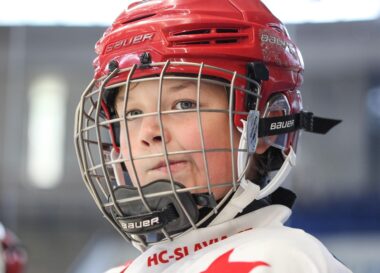Analyzing Shot Quality and Scoring Probability in Hockey
Hockey analytics has emerged as a vital component of understanding the game more thoroughly. One of the key aspects of this field involves analyzing shot quality and predicting scoring probabilities. Shot quality is generally assessed by evaluating various factors that influence a shot’s success. These factors include shot location, type of shot, and even the state of play. Advanced metrics such as Expected Goals (xG) allow analysts to quantify potential scoring rates, thus giving teams insights into offensive strategies. For instance, a high-quality shot taken from in close proximity to the goal usually generates a better scoring probability than a shot from the blue line. The evolution of data collection, including performance tracking systems, enables more accurate estimations of shot quality. Teams that efficiently leverage this data can optimize their shooting strategies. In addition, the incorporation of player-specific metrics into the analysis can yield deeper insights, allowing teams to tailor their approaches. As analytics evolve, becoming an indispensable part of the game, understanding these dynamics will better inform coaching and tactical decisions.
Another critical element in hockey analytics is the influence of defense on scoring chances. The effectiveness of opposing teams in limiting high-quality shots can significantly alter offensive strategies. Defensive metrics, such as how well players block shots or apply pressure on shooters, have garnered attention. Teams that excel at limiting high-danger scoring chances often possess a defensive structure that forces opponents into less favorable shooting positions. This structure might include tactics like maintaining proper gaps between defenders or using forechecking to disrupt opposing plays. Furthermore, intricate models can assess how various defensive formations affect shot quality. These analyses help coaches make informed choices regarding lineup adjustments and formation changes. Importantly, tools like video breakdowns are becoming increasingly common in assessing both offensive and defensive performances. By comprehensively analyzing the implications of defense on shot quality, teams can devise more effective strategies for both scoring and preventing goals. Overall, a well-rounded approach to analyzing the defensive game further enhances our understanding of shot quality and influences teams’ shot selection and execution during crucial moments.
Advanced Metrics in Shot Analysis
Utilizing advanced metrics is essential for improving shot quality assessments. Shot location is one of the primary factors when evaluating scoring probabilities. Models that analyze shot angle and distance from the net can determine which shooting scenarios yield higher success rates. These insights can be particularly beneficial for coaches and players as they formulate game strategies. Furthermore, metrics like Corsi and Fenwick provide data regarding puck possession and attempts, highlighting the interplay between offensive opportunities and shot quality. By examining trends in these analytics over time, teams can determine the effectiveness of their driving force in creating high-quality scoring chances. Statistically analyzing shots can pinpoint player tendencies as well. For example, a player might excel in certain areas of the ice, leading to a more prominent role in strategic planning. Analytics that utilize shooting efficiency percentages and conversion rates also play a role, revealing how well players convert opportunities into goals. Ultimately, with a deeper understanding of advanced metrics, teams can optimize their approach to maximize scoring chances while minimizing defensive vulnerabilities.
Moreover, another aspect of shot quality analytics involves the application of technological advancements in collecting data. Real-time analytics powered by tracking systems provide valuable insights into shooter positioning, goaltender reactions, and puck movement. Such technology enables teams to study player performance under various conditions, facilitating tailored coaching methods. The addition of artificial intelligence to model outcomes based on historical data has become increasingly popular. For instance, machine learning algorithms can analyze vast datasets to reveal previously unnoticed trends, helping teams gain competitive advantages. These insights also extend to goaltenders, where evaluating save percentages in relation to shot quality can enhance their training. By integrating technological innovations into their analytical processes, teams actively enhance their shot quality assessments. This seamless amalgamation of technology and analytics highlights the significance of evolving methodologies in sports. As our understanding of hockey becomes more sophisticated, teams can capitalize on these advancements, ultimately leading to a sharper focus on effective game strategies. The impact of technological integration cannot be understated in shaping modern hockey analytics.
The Role of Coaches in Implementing Analytics
Coaches play a pivotal role in harnessing analytics for enhanced shot quality evaluation. Their understanding and application of statistical insights can make a significant difference in team performance. By collaborating with analysts, coaches translate complex data into actionable strategies for players. This includes teaching players about shot selection and encouraging them to exploit favorable situations based on analytics. Coaches often need to balance traditional coaching methods with modern analytical insights. A significant challenge arises in convincing players of analytics’ importance, especially if they have previously relied on instinctual play. Therefore, fostering a culture that embraces data-driven decisions is essential. This cultural shift involves educating players on interpreting analytical findings and using them to refine their skills. Regular meetings to review metrics and devise strategies based on shot quality analyses can improve team dynamics. Furthermore, fostering open communication channels between coaching staff and analytics teams can enhance coherence and understanding across the organization. Ultimately, coaches play a crucial role in the successful integration of analytics into a team’s game plan, creating a stronger focus on shot quality and scoring probabilities.
Another vital element of shot quality analysis is the relationship between player positioning and shot efficacy. Analyzing how players position themselves before taking a shot often dictates scoring probability. Proper spacing and timing can enable players to maximize their effectiveness during game situations. For example, forwards who maintain an optimal distance from defensemen can enhance their shooting angles, thus increasing the likelihood of successful shots. Additionally, understanding defensive positioning is critical for offensive players. Metrics that evaluate players’ movement patterns before a shot can provide insights into how to exploit defensive weaknesses. This relationship between player positioning and shot quality emphasizes the tactical aspects of hockey. Game simulations utilizing analytics can reveal optimal positioning in various scenarios. This analytical approach encourages players to adjust their in-game behavior based on situational data. Techniques such as video analysis paired with statistical evaluations highlight the importance of positioning for scoring. Teams that successfully emphasize proper player positioning can elevate their chances of scoring, making this an essential area of focus for coaches and players alike.
Future of Hockey Analytics
As hockey analytics continues to evolve, the future holds immense promise for deeper understanding and better performance. Expanding data collection methods will enable even more refined evaluations of shot quality. With the ongoing rise of big data analytics, teams may implement more sophisticated models, predicting not just scoring chances but entire game outcomes based on historical data. This progression could even lead to real-time decision-making during games, enabling coaches to leverage analytics instantly to influence outcomes. Moreover, machine learning will likely play a greater role in enhancing predictive models, offering insights that are currently beyond traditional analytical methods. The integration of advanced technology will serve as a foundation for the next phase of hockey analytics, pushing teams toward unprecedented levels of performance analysis. While there are challenges related to data interpretation and application, the advantage of leveraging analytics cannot be underestimated. As teams become more adept at utilizing these methodologies, we can expect them to develop a competitive edge in the league. Overall, the future of hockey analytics appears bright as teams continue evolving in their quest for excellence.
Ultimately, the focus on shot quality and scoring probabilities is revolutionizing the sport of hockey. Understanding how various factors influence scoring chances allows teams to tailor their strategies effectively. This comprehensive approach, rooted in analytics, enhances the game’s enjoyment for players, coaches, and fans alike. As we delve into the future of hockey analytics, it’s evident that shot quality will remain at the forefront of these evolving discussions. The steady growth of data-driven methodologies is paving the way for a new era of decision-making and strategizing in hockey, further substantiated by growing public interest in advanced metrics. As the understanding of analytics improves, hockey can expect to see a wealth of benefits. Players can refine their skills based on analytical feedback, and teams can structure their game plans around data-driven insights. This dynamic landscape not only makes the game more exciting but also introduces an engaging narrative for fans invested in the metrics that drive their favorite teams. Every shot taken will increasingly become a calculated risk, deeply intertwined with advanced analytics, forever altering how hockey is played and appreciated.





